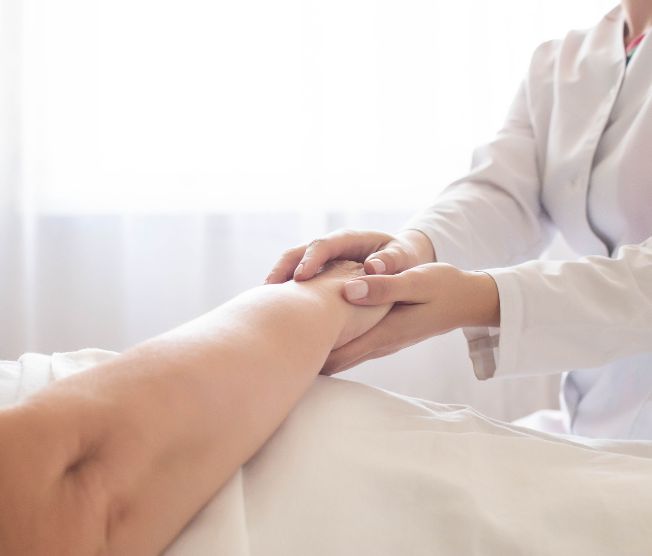 A bedsore is a type of ulcer that arises from pressure or friction repeatedly applied to one area. Individuals develop them after being bedridden for a period of time or having reduced sensation in one part of the body. In addition to staying in bed during injury or surgery recovery, this condition can occur from long-term wheelchair use or wearing a cast.
A bedsore is a type of ulcer that arises from pressure or friction repeatedly applied to one area. Individuals develop them after being bedridden for a period of time or having reduced sensation in one part of the body. In addition to staying in bed during injury or surgery recovery, this condition can occur from long-term wheelchair use or wearing a cast.
Bedsores are a significant concern for older adults. They can be a sign that a person is not being properly treated for a health concern like diabetes or is being positioned correctly in their bed or wheelchair. Understand how bedsores develop and ways to treat them.
What Are Bedsores?
Bedsores start to form after an area of the body does not receive enough blood and oxygen for at least two to three hours. At this point, the skin begins to dry out, resulting in a red or purple patch that may become an open sore.
Also known as pressure ulcers, bedsores extend beyond the skin, potentially to the muscles and bone. Due to age and health-related factors, healing can take months to years and medical intervention becomes necessary to prevent chronic wounds.
Due to a combination of friction and pressure, bedsores typically develop on the:
- Tailbone
- Hips
- Shoulder blades
- Heels
- Back of the head
- Back and side of the knees
- Back of the arms and legs
- Lower back
- Ankles
Additionally, these ulcers may develop where tubes or an instrument or device is placed. Based on condition, less-common areas may include the bridge of the nose from tubing or inside the mouth in response to dentures or a ventilation device.
Symptoms and Complications of Pressure Ulcers
Considering this development, the following signs indicate the progression of bedsores:
- Changes in skin color or texture
- Swelling
- Parts of the skin feeling warmer or more tender than others
- Drainage
- Fever
- Chills
- Infection
Bedsores progress through four stages:
- Initially, the skin looks red or purple and feels warm to the touch. The patient may also note a burning or itchy sensation.
- Open sores resembling a scrape or blister then develop. You may notice discharge and experience more pain. At this point, the epidermis has started to break down.
- Damage progresses into the muscle, with the sore taking on an indented appearance.
- Progression continues to the tendons, bones and joints, increasing the risk for infection and full-thickness tissue loss. The ulcer also starts to develop a crust of slough and eschar, which vary in color from tan, yellow or gray to green and black.
In addition to these changes, progressing bedsores make a patient more susceptible to cellulitis, a bone infection, sepsis or squamous cell carcinoma, a type of cancer.
Risks for Developing Bedsores
Individuals have a higher risk for bedsores if they are immobile, unconscious or confined to a bed or wheelchair. Existing health conditions, insufficient nutrition, circulation issues, exposure to moisture and situations increasing friction can also accelerate skin breakdown.
Common scenarios increasing your risk for bedsores include:
- Being immobile for an extended period of time
- Incontinence, which exposes the skin to urine and stool
- Decreased sensation in one area, which can result from a neurological condition
- Not getting enough hydration, protein, vitamins, minerals and calories
- Conditions affecting circulation, such as diabetes or vascular disease
- Cancer, cerebral palsy, dementia, heart failure, kidney failure, a spinal cord injury, spina bifida, peripheral artery disease or chronic venous insufficiency
Treatment and Care for Bedsores
If you or a loved one have developed bedsores, your medical team often prescribes a wound care regimen of applying dressings, cleansing and debriding the area and reducing pressure.
Treatment further encompasses nutrition, like increasing protein intake to improve healing, and may include negative pressure wound therapy, an antibiotic and skin grafts.
Long term, you’re advised to reduce your risks by:
- Inspecting your skin for signs of bedsores, especially around bony areas
- Turning or repositioning yourself or your loved one in a bed or wheelchair
- Adding padding around potential pressure points or using an ergonomic, adaptable wheelchair designed to relieve pressure
- Cleaning, drying and moisturizing your skin, ideally with a barrier cream
- Wiping away urine, stool, blood and moisture
- Taking a supplement to improve protein intake and enhance skin healing
- Strength training to improve upper-body strength, within your physical means
- Changing the elevation of your bed, with the head area placed up to 30 degrees higher than the foot area
- Managing your weight
- Stretching to improve circulation
- Ensuring you get enough sleep
Are you concerned about bedsores? Contact the medical team at Avon Health Center to discuss possible treatment options.
« 5 Ways Older Adults Can Remain Socially Connected

